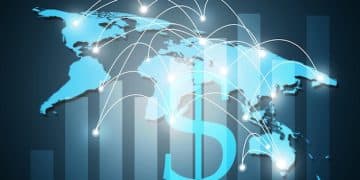US Inflation Rate at 2.5%: Expert Forecasts & Trends

The US inflation rate remains steady at 2.5%, prompting economic experts to analyze current trends and predict future economic shifts and potential impacts on consumers and markets.
The US inflation rate holds steady at 2.5%, a figure that carries significant weight for the American economy and its citizens. What does this stability mean for consumers, businesses, and the overall financial landscape?
Understanding the Current US Inflation Rate
The current inflation rate is a crucial metric for understanding the economic health of the United States. At 2.5%, it reflects the pace at which the general level of prices for goods and services is rising, impacting everything from consumer spending to investment decisions.
What Does 2.5% Inflation Signify?
A 2.5% inflation rate suggests moderate economic growth. It’s above the Federal Reserve’s 2% target, indicating that the economy is expanding, but not at a rate that would cause significant price instability. However, sustained periods above the target raises questions about policy adjustments.
This rate influences the purchasing power of the dollar. When inflation rises, each dollar buys fewer goods and services, which can affect household budgets and consumer behavior and investment decisions.
- Consumer Spending Habits: A stable inflation rate usually leads to predictable consumer spending, which is critical for the economy.
- Investment Strategies: Investors keep a close eye on inflation to make informed decisions about where to allocate their capital.
- Federal Reserve Policies: The Fed’s monetary policy decisions are heavily influenced by the prevailing inflation rate.
In conclusion, the US inflation rate at 2.5% is more than just a number; it’s a barometer of economic activity that impacts various facets of American life. Keeping an eye on this metric helps in understanding the current economic scenario.
Factors Contributing to Steady Inflation
Several factors play roles in maintaining a steady inflation rate. These factors include global economic conditions, domestic policies, and consumer demand which collectively drive the inflationary trends in the US.
Global Economic Influences
The global economy has a ripple effect on US inflation. Changes in international trade, supply chain disruptions, and global demand can affect the prices of imported goods and raw materials.
For example, fluctuations in oil prices or trade tensions with other countries can directly impact the cost of goods and services in the US. These global factors can either exacerbate or mitigate domestic inflationary pressures.
Domestic Policies and Their Impact
Government policies, such as fiscal spending and tax regulations, also influence inflation. Increased government spending can stimulate demand, potentially leading to higher prices, while tax cuts can boost consumer spending, which can increase the speed of inflation.
- Fiscal Spending: Government investment in infrastructure and other projects can increase demand.
- Tax Policies: Changes in taxation can affect disposable income and consumer behavior.
- Regulatory Environment: Regulations can impact business costs, influencing prices.
In summary, steady inflation is a result of interplay between global economic conditions and domestic policy decisions, making it important to keep these two things in mind. Government also has to think about the monetary policies.
Expert Predictions for Future Inflation Trends
Economic experts closely monitor various indicators to forecast future inflation trends. These predictions are essential for businesses, policymakers, and consumers to prepare for potential economic shifts.
Key Economic Indicators to Watch
Experts often look at metrics such as the Producer Price Index (PPI), Consumer Price Index (CPI), and employment figures to gauge the direction of inflation. These indicators provide insights into supply-side and demand-side pressures on prices.
Changes in these indicators can signal potential shifts in inflation. For instance, a rise in the PPI might suggest that manufacturers are facing higher costs, which could eventually be passed on to consumers through higher prices.

Potential Scenarios and Outcomes
Different economic scenarios could lead to varying inflation outcomes. A strong and sustained economic recovery might push inflation higher, while a slowdown could lead to disinflation or even deflation.
- Strong Economic Growth: Increased demand could lead to higher prices.
- Economic Slowdown: Reduced demand might result in disinflation.
- Geopolitical Instability: Global events could disrupt supply chains and drive up prices.
To conclude, predicting future inflation trends involves a thorough analysis of economic indicators and a careful assessment of potential economic scenarios. These predictions help in making well-informed decisions.
Impact on Consumers and Businesses
Inflation has a multifaceted impact on both consumers and businesses. Understanding these impacts is crucial for making sound financial decisions and adjusting business strategies accordingly.
How Inflation Affects Purchasing Power
When inflation rises, the purchasing power of consumers decreases. This means that people can buy fewer goods and services with the same amount of money, which can lead to changes in spending habits.
Consumers may cut back on discretionary spending and prioritize essential items. This shift in consumer behavior can have a ripple effect on businesses, affecting their sales and profitability.
Inflation’s Influence on Business Strategies
Businesses must adapt their strategies in response to inflation. This might involve adjusting pricing, managing costs, and making strategic investments to maintain profitability.
For example, businesses might need to raise prices to cover increased costs, but they must do so carefully to avoid losing customers. Effective cost management and strategic investments can help businesses navigate inflationary periods successfully.
In brief, inflation’s impact on consumers includes reduced purchasing power, and for businesses, it necessitates strategic adjustments to maintain profitability, both of these contribute heavily to economic performance and stability.
The Role of the Federal Reserve
The Federal Reserve plays a vital role in managing inflation and maintaining economic stability. Its monetary policy tools are instrumental in influencing inflation rates and ensuring sustainable economic growth.
Monetary Policy Tools and Inflation Control
The Fed uses various tools to control inflation, including adjusting the federal funds rate, setting reserve requirements, and conducting open market operations. These tools affect the money supply and credit conditions, which in turn influence inflation.
Challenges Faced by the Federal Reserve
The Federal Reserve faces several challenges in its efforts to manage inflation. These include balancing inflation control with promoting employment, dealing with external economic shocks, and navigating the complexities of modern financial markets.
- Balancing Act: Managing inflation while promoting employment.
- External Shocks: Responding to unexpected global events.
- Market Complexity: Navigating intricate financial systems.
In Summary, the Federal Reserve has a significant role in controlling inflation and ensuring economic health. These actions are for influencing the money supply and credit conditions, which can contribute towards stability.
Strategies for Managing Inflation Risks
Consumers and businesses can employ various strategies to mitigate the risks associated with inflation. These strategies involve financial planning, cost management, and investment diversification.
Financial Planning for Inflation
Consumers can protect themselves from inflation by creating a detailed financial plan that includes budgeting, saving, and investing. This plan should account for rising prices and ensure that income keeps pace with inflation.
Strategies include negotiating salary increases, reducing debt, and investing in assets that tend to appreciate with inflation. By taking proactive steps, consumers can safeguard their financial well-being during inflationary periods.
Investment Diversification
Diversifying investments across various asset classes can help mitigate inflation risk. Investing in assets such as real estate, commodities, and inflation-protected securities can provide a hedge against rising prices.
These assets tend to maintain or increase their value during inflationary periods, helping to preserve purchasing power. A well-diversified portfolio can provide a buffer against the negative effects of inflation.
| Key Point | Brief Description |
|---|---|
| 📊 Current Inflation | US inflation holds steady at 2.5%, indicating moderate economic growth. |
| 🌍 Global Factors | Influenced by trade tensions, supply chains, and global demand. |
| 💼 Business Strategies | Businesses must adjust pricing and manage costs to maintain profitability. |
| 🏦 Federal Reserve | Uses monetary tools to control inflation and promote economic stability. |
Frequently Asked Questions (FAQ)
▼
Economists typically consider an inflation rate of around 2% as ideal for a healthy economy. This level promotes stable prices and encourages spending and investment.
▼
Inflation can erode the value of savings if the interest rate earned on the account is lower than the inflation rate. This reduces the purchasing power of your savings over time.
▼
Inflation-protected securities, such as Treasury Inflation-Protected Securities (TIPS), are designed to protect investors from inflation by adjusting their principal value with changes in the CPI.
▼
Yes, deflation can be more harmful than mild inflation. Deflation can lead to decreased spending, as consumers delay purchases in anticipation of lower prices, leading to economic stagnation.
▼
Businesses can adjust to inflation by optimizing supply chains, improving efficiency, and adjusting pricing strategies to maintain profitability while remaining competitive in the market.
Conclusion
In conclusion, the US inflation rate holding steady at 2.5% presents a complex economic picture. Understanding its implications, the factors contributing to it, and strategies for managing its risks are crucial for consumers and businesses alike.





